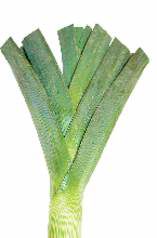At the Market: Leeks
Published 5:00 am Tuesday, June 21, 2011

- Sauteing, roasting and braising all yield good results when cooking leeks.
At the Market is a weekly look at produce available at local farmers markets.
Leeks are a favorite member of the allium family — a family that also includes onions and garlic — and spring is an excellent time to buy them at farmers markets.
Spring leeks are generally more slender and tender than they are come fall. Look for specimens with bright green leaves and moist, flexible root ends (if the white root end is rigid, the leek will be very tough).
While the entire leek is edible, only the white root end portion imparts the pungent oniony flavor leeks are beloved for, according to “The Science of Good Food” by David Joachim and Andrew Schloss. Growers try to maximize the length of the white portion by mounding soil around the leek as it grows, shielding it from sunlight.
Leeks contain fewer sugars and more long-chain carbohydrates than regular onions, say Joachim and Schloss. That means they obtain a slippery texture when cooked that helps to thicken soups and stews.
If there is one drawback to leeks, it is the grit that tends to build up between their layers. The concentric layers of the leek (each layer is a swollen leaf base) trap dirt between them as they grow. The only sure way to remove the grit is to expose all the layers before introducing them to water. Slice leeks into discs, then separate each disc into rings and deposit into a sinkful of cool water. Agitate the water, then walk away for five minutes to let the grit settle to the bottom of the sink. Scoop out the leeks and rinse.
If your recipe calls for larger pieces of leek, not rings, slice the leek in half lengthwise, separate into water and then clean as above.
Try adding leeks to a simple vegetable saute to throw over pasta or rice. Roasting until softened and slightly brown or braising in a liquid such as wine also increases the sweetness of the leek.






